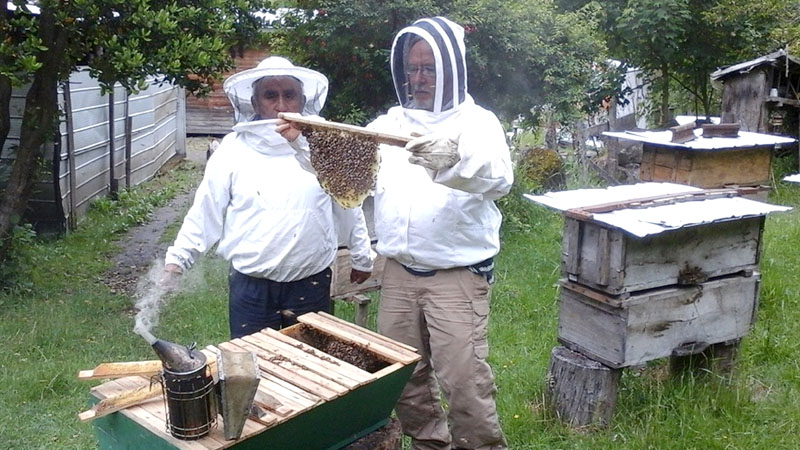
The Beekeeping Project is for the Well-beeing of All Creation
Our late friend, Pastor Francisco Catrin, asked us to help a neighbor of his in Llongahue, Adolfo. When we walked into his bee-yard, it felt like stepping back into time.
Adolfo was keeping bees in rustic boxes of scrap lumber, much like ancient beekeepers kept bees in logs or clay cylinders.
This is common in rural areas around the world where beekeepers don’t have access to modern supplies.
Adolfo’s problem was that he had to destroy the hive in order to harvest honey. These are fixed-comb hives, unlike movable-comb hives that allow us to harvest honey without destroying bees. His rustic method made it difficult for him to increase the number of beehives he kept.
But if we introduce him to this kind of hive (the hive shown in photos 6 and 7) are we really helping him?
Beekeeping can end in problems when separated from what is good for the bees and the planet, and from what is economically feasible for the beekeeper.
Sustainable beekeeping training practices have a place in our missiology. Just look at these two excerpts from International Ministries’ new vision statement, Responding to the Call:
“The narrative of Scripture and, most especially, Jesus himself reveal that God’s mission is nothing less than the healing, reconciliation, liberation and salvation of all of creation (2 Corinthians 5:19; Ephesians 1:9-10).”
“International Ministries will promote care for God’s creation through improved agricultural practices, promoting the use of renewable resources and environmental stewardship.”
And this is where top-bar hives come in. But first, some background.
The modern, I daresay, industrialized way of beekeeping uses rectangular boxes with movable frames of honeycomb. The bees lay eggs, store pollen and nectar in the combs. They draw out the wax, transform the nectar into honey, and cap each cell with wax. They store honey in more boxes set on top of the brood nest. These boxes can weigh 60-plus pounds, which is why many beekeepers have aching backs.
The disadvantages for someone like Adolfo are:
Conventional beekeeping pushes the use of toxic applications to kill a parasitic mite, also.
Because of their efficiency and productivity we will continue teaching the use of these hives, but we are moving to a treatment-free, natural approach to the pest problems.
What did bees do before beekeeping?
This is the approach that will help the bees and the beekeepers the most.
Top-bar hives are simpler, less expensive, and more like the way bees live in nature. The box is long, with diagonal sides. The bees build their own comb from bars placed across the top. Bees naturally build comb in deep catenary curves, not in squares, and they are free to build different cell sizes for worker bees and drones.
The top-bar hive can produce an adequate harvest, but the emphasis is on the health of the bees, not production at all cost.
Adolfo is learning the top-method now. Slowly, we will catch swarms from his rustic boxes and populate top-bar hives with them, and Adolfo will have a productive, thriving bee-yard.
We call this work pastoral apiculture because the bees open doors for us to pray with the beekeepers, share a meal with them, and talk about the Kingdom of God. Recently, Adolfo’s wife suffered a slight stroke. We prayed for her and she has recovered most of her mobility!
Now we are beginning to train women beekeepers
Up till now, we have worked only with men. Now we believe the top-bar hive will make it easier for women to work with bees.
We now are working with our first woman beekeeper, Silvia! She is learning about bees using the modern, conventional hives, but next year she will learn to make and use the top-bar hive.
“One can no more approach people without love than one can approach bees without care. Such is the quality of bees…”As we move into making products, like lip balm and candles, with the beeswax left over after harvesting, the whole family can participate and create more income.
– Leo Tolstoy